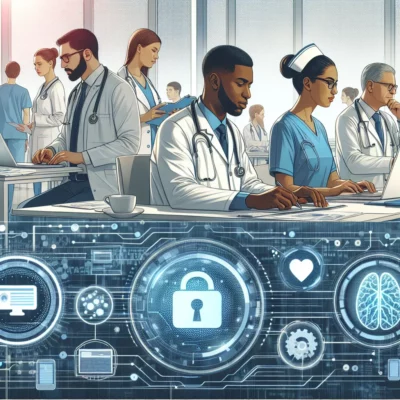Understanding the Importance of Data Security in Healthcare
In today’s digital age, patient data is more critical and sensitive than ever before. Healthcare facilities handle vast amounts of personal information, from medical histories to insurance details, making them prime targets for cyberattacks. The consequences of data breaches in healthcare settings can be severe, including financial loss, legal repercussions, and most importantly, loss of patient trust.
Data security plays a pivotal role in maintaining patient trust and ensuring compliance with various regulations. When patients know their information is safe, they are more likely to be open and honest with their healthcare providers, leading to better care outcomes. Additionally, adhering to data security standards is not just a best practice but a legal requirement in many jurisdictions.
Regulatory Requirements and Compliance Standards
Healthcare facilities must navigate a complex landscape of regulatory requirements to protect patient data. Key regulations include:
- HIPAA (Health Insurance Portability and Accountability Act): In the United States, HIPAA sets the standard for protecting sensitive patient data. Healthcare providers must ensure that all physical, network, and process security measures are in place and followed.
- GDPR (General Data Protection Regulation): In Europe, GDPR imposes strict rules on data protection and privacy, with significant penalties for non-compliance.
To ensure compliance with these regulations, healthcare facilities should:
- Conduct Regular Audits and Assessments: Regularly review and update security policies and procedures.
- Implement Comprehensive Security Policies: Develop and enforce policies that cover all aspects of data security.
- Train Employees: Ensure that all staff members are aware of and adhere to data protection regulations.
Implementing Robust Security Measures
Securing electronic health records (EHRs) is a critical aspect of protecting patient data. Best practices include:
- Encryption: Encrypting data both at rest and in transit to prevent unauthorized access.
- Firewalls: Using firewalls to protect internal networks from external threats.
- Secure Access Controls: Implementing multi-factor authentication and role-based access controls to ensure that only authorized personnel can access sensitive information.
Regular software updates and vulnerability assessments are also crucial. Outdated software can have security flaws that cybercriminals can exploit. By keeping systems up-to-date and regularly assessing vulnerabilities, healthcare facilities can mitigate potential risks.
Employee Training and Awareness
Human error is one of the leading causes of data breaches. Comprehensive training programs for staff are essential to foster a culture of security awareness. Strategies include:
- Regular Training Sessions: Conducting regular training sessions to keep staff updated on the latest security practices.
- Phishing Simulations: Running phishing simulations to educate employees on recognizing and responding to phishing attempts.
- Clear Communication Channels: Establishing clear channels for reporting security incidents or suspicious activities.
Common pitfalls, such as weak passwords and sharing sensitive information over unsecured channels, can be avoided through continuous education and awareness.
Leveraging Technology for Enhanced Security
Advanced technologies like artificial intelligence (AI) and machine learning can significantly enhance data security. Benefits include:
- Anomaly Detection: Using AI to detect unusual patterns that may indicate a security breach.
- Automated Responses: Implementing automated responses to potential threats, reducing response times and mitigating damage.
Secure cloud storage solutions offer another layer of protection by providing robust security measures and regular backups. Additionally, cybersecurity tools and services, such as intrusion detection systems and security information and event management (SIEM) systems, play a crucial role in protecting patient data.
Incident Response and Recovery Plans
Despite the best efforts, data breaches can still occur. Having an effective incident response plan is essential for minimizing damage and recovering quickly. Key steps include:
- Immediate Action: Isolate affected systems to prevent further damage and assess the extent of the breach.
- Communication: Notify affected parties, including patients, regulatory bodies, and internal stakeholders.
- Investigation: Conduct a thorough investigation to determine the cause of the breach and identify any vulnerabilities.
Long-term strategies for recovery and prevention of future breaches include:
- Regularly Updating Security Protocols: Continuously improving security measures based on lessons learned from past incidents.
- Conducting Post-Incident Reviews: Reviewing the incident response process to identify areas for improvement.
Partnering with Trusted Vendors
Healthcare facilities often rely on third-party vendors for various services, from cloud storage to software solutions. Selecting secure and compliant vendors is crucial for maintaining data security. Criteria for selecting vendors include:
- Compliance: Ensuring that vendors comply with relevant regulations and standards.
- Security Practices: Evaluating the vendor’s security practices, including encryption, access controls, and incident response plans.
- Reputation: Choosing vendors with a strong track record of data security.
Vendor risk assessments should be conducted regularly to ensure ongoing compliance and security standards. Maintaining open communication with vendors and conducting periodic reviews can help healthcare facilities stay ahead of potential risks.
By understanding the importance of data security, adhering to regulatory requirements, implementing robust security measures, fostering a culture of security awareness, leveraging advanced technologies, preparing for incidents, and partnering with trusted vendors, healthcare facilities can safeguard patient data and maintain trust in an increasingly digital world.
